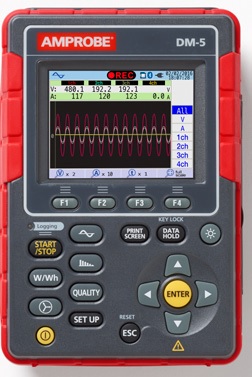Amprobe DM-5 Power Quality Analyzer and Logger Review
Hello, today we will be reviewing the Amprobe DM-5 Power Quality Analyzer. This is the newest entry from Amprobe in power quality analysis and is an upgrade over previous models. The Amprobe DM-5 Power Quality Analyzer simultaneously measures power, harmonics, waveform, and power quality for voltage (3-channel) and current (4-channel). It features a color display and Bluetooth capabilities for real-time remote monitoring. Power quality analysis is a great preventative maintenance tool to add to your company’s MRO profile because it helps eliminate wasted energy and reduces equipment failure or damage which can affect the bottom line either through high energy bills or equipment downtime.
This is the newest entry from Amprobe in power quality analysis and is an upgrade over previous models. The Amprobe DM-5 Power Quality Analyzer simultaneously measures power, harmonics, waveform, and power quality for voltage (3-channel) and current (4-channel). It features a color display and Bluetooth capabilities for real-time remote monitoring. Power quality analysis is a great preventative maintenance tool to add to your company’s MRO profile because it helps eliminate wasted energy and reduces equipment failure or damage which can affect the bottom line either through high energy bills or equipment downtime.
The Amprobe DM-5 includes a thin flex current sensor with user selectable input ranges of 300, 1000, and 3000 Amps. It also features 10 selectable wiring connection settings for measuring single and three-phase power systems. Below is a complete list of measurements and parameters the DM-5 Power Quality Analyzer will analyze.
- Voltage
- Current
- Frequency
- Active / Reactive / Apparent Power
- Active / Reactive / Apparent Energy
- Power Factor (cos θ)
- Neutral Current
- Demand
- Harmonics
- Quality (Swell / Dip / Interruption, Transients / Overvoltage, Inrush Current, Unbalance Rate)
- Capacitance Calculation for PF Correction Unit
- Flicker

I want to cover a few specific issues you might encounter that will lead you to purchase a power quality analyzer. The first issue I want to discuss is flicker. Flicker is something everyone has encountered at some point in their life when a lightbulb flickers but can be experienced in an industrial setting with large electric motors. Rapid fluctuations in voltage can be one reason for these flickers. Flickers are important to avoid if you are using sensitive electrical equipment that rely on constant electric power.
The next issue I want to discuss is harmonics. Harmonics usually occur when using a non-linear electric load. For most devices the load would be linear and would draw from the power system with a matching sinusoidal current and frequency but out of phase. A non-linear, as the name would suggest, does not draw its current in a set linear fashion or even sinusoidal for that matter. While they can be estimated as a series of sinusoidal equations they will still lead to disturbances. These disturbances can be considered continuous and are found during steady-state and repeated during every cycle. These harmonics ideally want to be minimized as they can lead to an increase in motor temperatures which can shorten the life of the motor.
The final topic I want to discuss is transients. Transients are classified as short electrical events that cause a sudden change in the state of the electrical system. Transients are hard to pin down as they are so short and can be caused by something internal or external such as a lightning storm. Two common transient events that you are likely to experience are swells and dips. A swell is when voltage exceeds the nominal voltage by 10+% for up to 1 minute. A dip is the natural opposite of a swell and is when voltage is below the nominal voltage by 10+% for up to 1 minute.

The Amprobe DM-5 Power Quality Analyzer can be utilized to look for all of these things with its capability to record with user defined intervals. This is excellent because, as stated earlier, these events can last up to 1 minute and are very often just a few seconds or cycles. Once you have finished recording you can see some graphs directly on screen or can use the provided software for full blown analysis and report generation. The Amprobe DM-5 is a full kit that includes all of the clamps and clips you will need to do full system checks.






Add new comment